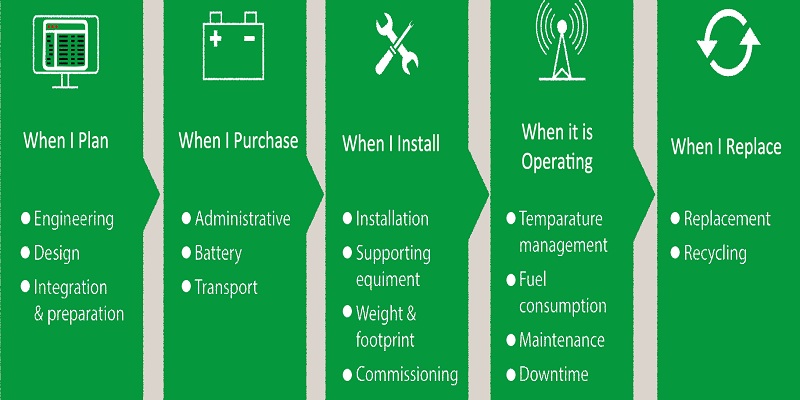EverExceed has drawn on a long field experience in supplying batteries for
telecom applications to identify Five Golden Rules for a TCO analysis that will result in a fully informed smart decision. These five golden rules will be discussed in this forum in a weekly series. Today we are going to describe Rule number 1.
Rule 1: Know your current spending
At each project stage you must identify clearly all the associated costs, both visible and hidden. This covers five main stages:

Planning
• The engineering time to build models, create estimates and carry out site surveys.
- This work could be internal or might involve external contractors and hence additional costs.
• Designing all the ancillary equipment associated with the battery such as selecting a cabinet, racking, and connectors and so on.
• Integration and preparation time (cabinet, remote site preparation etc.)
- Heating ventilation and air conditioning (HVAC) systems where required.
- Floor reinforcement to support the weight of the battery.
Purchasing
• There can be significant administrative costs in the purchases process, especially if the number of purchase orders (POs) to be raised begins to multiply. Generally, a typical PO can cost $50 to $200 simply to process.
- Vendor Managed Inventory (VMI) can also add to costs.
• Battery cost. There is no single type of battery to suit all telecom applications. The battery technology and size selected, and therefore its cost, will vary depending on if it is required to support energy, power, floating, cycling etc.
• Transportation costs. These vary according to battery weight, how remote the site is and the ease of access. This may include including the hire of helicopters, barges or snow cats all of which add significantly to the installation cost.
- There will be some extreme cases, such as the Arctic, where no site access is possible for several months of the year.
- Even in urban sites obtaining access permissions from landlords can take time;
Installation
• The time to install a battery depends on its type, weight and volume. It can be useful to undertake time and motion studies when a large fleet of batteries is to be rolled out.
• Large roll-out programs may also require warehousing for storage of batteries prior to installation.
• Additional site equipment might be needed such as HVAC or thermal electric cooling (TEC) systems as well as provision for low voltage battery disconnect (LVD) and temperature compensated voltage control.
• Time also needs to be allowed for commissioning. Typically, this will be a baseline state of charge (SOC) test and acceptance procedure. The time required will depend on the battery type, for lead-acid batteries it can be a lengthy process while the high recharge efficiency of
Lithium batteries makes it much faster.
Operation
• The installation will require utility power to maintain the operating temperature at the correct level. This will differ between
lead-acid,
Ni-Cd and
Li-ion batteries. Modern batteries can be hardened to operate at higher temperatures than legacy batteries, resulting in saving power and therefore costs.
• For floating applications, it should be remembered that not all batteries float at the same current. Float current is used to maintain the battery at 100 percent SOC ready for action.
For one or two sites supplying a float charge of milliamps is a negligible cost. However, once 5,000 or more sites are involved the float charge cost becomes significant.
•Fuel consumption is an important consideration at sites that rely on gensets, such as hybrid installations. A lead-acid battery might require a charge input of 120 to 140 percent to achieve 100 percent SOC. In contrast, more advanced battery technology offers higher recharge efficiency – Li-ion is 99.9 percent efficient – that enables the genset run time to be reduced, this cuts fuel consumption and therefore costs.
•Maintenance will involve time and travelling costs and potentially access challenges. Increased maintenance intervals mean reduced costs.
• For mission critical installations, unplanned battery failures can result in loss of revenue and maybe even performance penalties.
• Battery replacement frequency during telecom equipment lifetime – how many times will new batteries is required over 20 years or so because a reliable, long life battery was not specified at the outset?
•Real estate costs can be an important consideration, especially in urban installations where space is at a premium. New battery technology, especially Li-ion, can keep the installation footprint to a minimum.
Replacement
• When the battery reaches the end of its life then there is a time and manpower cost to replace it.
• The old batteries will also need to be removed from the site and transported to a suitable recycling facility.
• There can be external factors other than lifetime that determine the frequency of battery replacement.
For example, in some regions of the world lead-acid batteries are targeted for theft and vandalism, while the form factor of Ni-Cd and Li-ion batteries makes them loss prone to these attacks.
There are also some other factors that should be considered when making an overall assessment of the environmental impact and social cost of a battery, including the emissions created during the manufacturing phase.
If you need to discuss more about the planning, purchasing, installation, operation and replacement of your telecommunication batteries, feel free to communicate with EverExceed experts. We are always here to support you!

